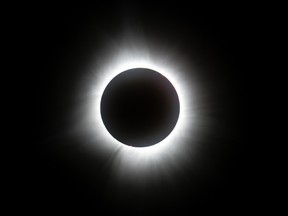
Science is two things: The curiosity to constantly ask questions and stubbornness to go find the answers.

Article content
I hadn’t expected it to get so cold. Silly, I suppose. We were about to experience a total solar eclipse — what did I expect to happen when the sun went away?
The light on the ground and reflected through trees became dusky. We were around a dozen people in a spacious Hemmingford-area back yard and most of us were crowded around one person, launching questions at her like sounding rockets.
Advertisement 2
Article content
Article content
She is Barb Mattson, an astrophysics communications scientist who works for the University of Maryland at NASA’s Goddard Space Flight Centre. She studies things outside our solar system, but she knows more about eclipses than most of us — this was her third experience in a path of totality.
Her honeymoon eclipse was on a cruise ship in the Mediterranean with husband Andrew Kuchling. The cruise line had embraced the experience, with plans to change course if needed for the best view. Yet there weren’t the same cues you experience on land, she said, because everything was sky and ocean.
The 2017 eclipse, which she viewed from her parents’ home by a river in Tennessee, was a completely different experience.
“We could see the ground getting darker,” she says. “We could see our surroundings getting darker. It’s hard to describe, you know, it just felt weird and neat.”
Weird, neat and breathtaking. The barrage of questions halted at the moment of totality as we removed our glasses and stared in awe at the moon covering the sun. Mattson had told me days ago there are no words to describe an eclipse. I get it now.
Article content
Advertisement 3
Article content
All you need is curiosity
Mattson thinks back to a time when she was struggling in grad school. A member of her team gave her the best advice she’s ever had: “You don’t have to have great smarts. The only two things you have to have are curiosity and stubbornness. Embrace that.”
You need the curiosity to constantly ask questions and the stubbornness to go find the answers.
Mattson’s family had memberships to the Science Museum of Minnesota most years from the time Mattson was in grade school.
Advertisement 4
Article content
“I don’t know if my parents knew it was what they were doing, but they were fostering that curiosity and the love of science, showing what science can be,” she said.
“Kids want things they can touch and feel, even if they’re just touching it for a minute” while they’re at the museum. “They’re experiencing their environment. That’s the science.”
Not all families can afford memberships to their local science museum, but there are other opportunities, she said. Libraries are one of the best ways to reach everybody because they are accessible and often have activities that level the scientific playing field.
It’s OK if you don’t know the answer
“I know everything,” my dad used to say, “and what I don’t know, my brother knows.”
It’s a myth we want our children to believe, that we know it all. Of course we don’t, and Mattson embraces that.
“As a scientist, I love saying, ‘I don’t know’ because that is an opportunity to find out something new. Saying the next part is really important: ‘I don’t know, but how could we find out?’”
On a day when there is time for exploration, that could mean visiting our good friend Google, she suggested. Or it might be going to the library. It might be doing a little experiment, such as one developed by the Family ASTRO program that shows why we don’t have an eclipse every month.
Advertisement 5
Article content
All you need is a styrofoam ball, a light bulb and your eyes.
The ball is your moon, the light bulb the sun, and your child’s head is the Earth. Put the ball on a stick and move the moon around in an orbit. When it gets between the child and the sun, they can orient it so it doesn’t block their eyes.
“That starts to tell them, ‘Oh, it must be a little above or below where the sun is’,” Mattson said. “Plus, your kid is spinning around and expending some energy.”
An eclipse made Einstein a rock star
A solar eclipse was the first proof of Albert Einstein’s general theory of relativity, which predicted that gravity will bend starlight.
The sun is the “strongest source of gravity in our neighbourhood,” NASA tells us, and starlight passing the edge of the sun will alter where the stars appear — by about the width of a dime. The only way to see those stars close to the sun is during an eclipse. Two teams in 1919 photographed an eclipse and compared the images with those taken within a few months. General relativity had predicted the positions of the stars.
We’re still learning from solar eclipses. NASA launched sounding rockets and WB-57 high-altitude planes from the Wallops Flight Facility in Virginia to conduct at least six different experiments right before and after Monday’s eclipse. They’ll learn about the ionosphere, which is part of Earth’s upper atmosphere.
Advertisement 6
Article content
“Our atmosphere is constantly bombarded by particles from the sun,” Mattson said. “When you have an eclipse, you are blocking a tiny bit of the atmosphere from that, which can have some effects on our ionosphere.”
You’re blowing my mind, I told her.
“That’s a scientist’s job,” she said.
Sign up for our awesome parenting and advice newsletter at montrealgazette.com/newsletters.
MORE ECLIPSE FUN
Educational activities related to the eclipse are available on the NASA website: https://tinyurl.com/y5vpuhu3
Just for fun, a video game about eclipses and transits (when other things pass between us and the sun: https://tinyurl.com/ycyexxhz
Recommended from Editorial
Advertisement 7
Article content
Article content





































